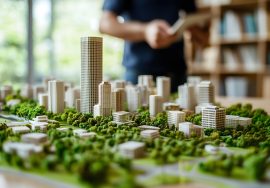
Sustainable Landscaping: Greening Spaces Responsibly
Sustainable Landscaping: Greening Spaces Responsibly
In a world increasingly focused on sustainability, even outdoor spaces are being redesigned to reduce environmental impact. Sustainable landscaping is an innovative approach to garden and landscape design that conserves resources, supports biodiversity, and minimizes pollution.
Whether for homes, offices, or public spaces, sustainable landscaping creates beautiful, functional, and eco-friendly environments that thrive naturally — without harming the planet.
What Is Sustainable Landscaping?
Sustainable landscaping is the practice of designing, constructing, and maintaining landscapes that are environmentally responsible and resource-efficient. Unlike traditional landscaping, which often relies on chemical fertilizers, excessive water, and non-native plants, sustainable landscaping focuses on natural balance and long-term health.
The main goal of sustainable landscaping is to work with nature rather than against it — creating outdoor spaces that are self-sustaining, low-maintenance, and beneficial to the local ecosystem.
Core Principles of Sustainable Landscaping
A successful sustainable landscaping design integrates ecological, aesthetic, and functional elements. Here are the key principles:
1. Native and Drought-Tolerant Plants
Using native species suited to the local climate reduces the need for extra water, fertilizers, and maintenance. These plants naturally support pollinators and wildlife, promoting ecological balance.
2. Water Conservation
Techniques such as rainwater harvesting, drip irrigation, and mulching help preserve water. Efficient watering practices are essential for sustainable landscaping in water-scarce regions.
3. Soil Health and Composting
Healthy soil forms the foundation of sustainable landscaping. Adding organic compost improves fertility and structure, reducing the need for synthetic fertilizers.
4. Energy Efficiency
Strategic planting — such as shading buildings with trees — can lower indoor temperatures, reducing energy use and improving energy efficiency.
5. Waste Management
Recycling garden waste through composting or mulching reduces landfill contribution and enriches the landscape naturally.
Benefits of Sustainable Landscaping
Embracing sustainable landscaping offers numerous environmental and economic benefits:
-
Water Conservation: Native plants and smart irrigation reduce water use dramatically.
-
Low Maintenance: Sustainable landscapes require less mowing, fertilizing, and upkeep.
-
Biodiversity Support: Natural habitats attract pollinators, birds, and beneficial insects.
-
Improved Air Quality: Plants filter air pollutants and contribute to indoor air quality when used near open spaces.
-
Enhanced Property Value: Eco-friendly landscaping increases visual appeal and long-term value.
Moreover, sustainable landscaping contributes to urban sustainability, helping cities become greener and more resilient.
Techniques for Sustainable Landscaping
Here are practical ways to apply sustainable landscaping principles:
1. Xeriscaping
This method emphasizes drought-tolerant plants and minimal irrigation — ideal for dry regions like Rajasthan or Gujarat.
2. Rain Gardens
Rain gardens capture and filter stormwater runoff, reducing flooding and replenishing groundwater.
3. Green Roofs and Walls
Integrating green roofs or living walls improves insulation, reduces heat, and enhances energy efficiency.
4. Permeable Surfaces
Using materials like gravel, permeable pavers, and turf blocks allows rainwater to seep into the soil, reducing runoff and erosion.
5. Smart Irrigation
Smart building technology now includes sensors and timers that deliver water efficiently, preventing waste.
Sustainable Landscaping in India
India’s growing urban population and changing climate make sustainable landscaping vital for both rural and urban areas. Many Indian architects and landscape designers are now incorporating native plants, water-efficient designs, and eco-friendly design principles into public and private spaces.
Cities like Bengaluru and Pune have introduced sustainable landscaping in parks and residential complexes to combat heat islands and improve air quality.
For more information on India’s green initiatives, visit the Indian Green Building Council (IGBC) — an organization promoting eco-conscious building and landscape design across the country.

How to Create a Sustainable Landscape
If you’re planning to design a sustainable garden or outdoor space, here’s how to get started:
-
Assess the Site: Understand soil type, sunlight, and rainfall patterns.
-
Choose Native Plants: Prioritize species that thrive naturally in your region.
-
Install Rainwater Harvesting Systems: Collect and reuse rainwater efficiently.
-
Use Organic Fertilizers: Replace chemicals with compost or natural mulch.
-
Plan for Long-Term Growth: Design landscapes that evolve sustainably over time.
For professional assistance with sustainable landscaping, contact AMS India. Their team specializes in eco-friendly landscape and building design that enhances both beauty and sustainability.
The Future of Landscaping Is Sustainable
As environmental challenges grow, sustainable landscaping is becoming an essential part of responsible design. It merges functionality, aesthetics, and ecology to create outdoor spaces that support both human life and the environment.
From residential gardens to large urban parks, sustainable proves that green beauty doesn’t come at the expense of the planet.
Conclusion
Sustainable represents the future of outdoor design — one that values resource conservation, biodiversity, and long-term health over short-term beauty.
By adopting sustainable , we can transform our surroundings into eco-friendly sanctuaries that thrive naturally, conserve resources, and build a greener world for generations to come.
Read more related articles to enhance your knowledge and make informed decisions
Cost-Effective Modular Construction: Fast, and Sustainable Building Solutions
Smart Modular Buildings: Innovative, Efficient, and Sustainable Construction








